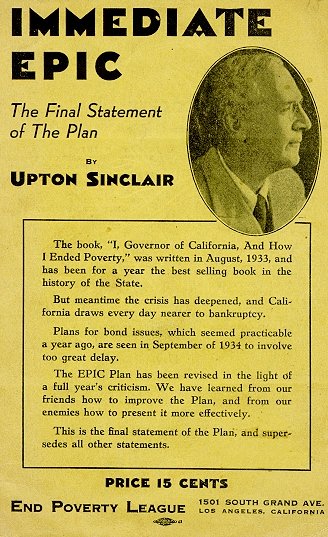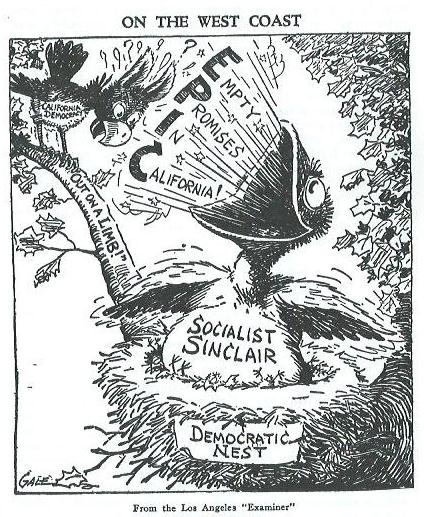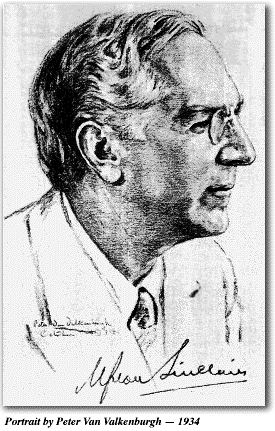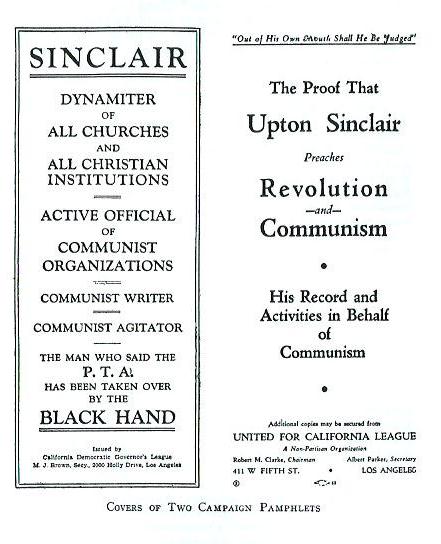Upton Sinclair's 1934 campaign for governor of California has been called "the Campaign of the Century." One of the most dramatic and influential contests in California history, it helped change the political landscape of the nation.
This project explores the campaign and the End Poverty in California (EPIC) program that captured international attention in 1934. Here you will detailed accounts and a wealth of primary sources, including political cartoons, newspaper and magazine articles, campaign pamphlets, pages from Upton Sinclair's Epic News (the campaign newspaper), and Upton Sinclair's writing during and after the campaign.
- - - - -
Upton Sinclair had just celebrated his birthday. Fifty-five years old, he was one of America's best known writers. He was also one of the best known Socialists, having joined the party of Eugene Debs and Jack London early in the century. Now he was walking away from the commitment of thirty years. It was September 1933 and Upton Sinclair was in the Beverly Hills city hall registering to vote as a member of the Democratic party.
It was the opening moment in a campaign that would soon capture national attention while transforming political life in California. A few days later he declared his candidacy for governor of the state and began to distribute a 63 page booklet that outlined his platform. Carrying the futuristic title, I, Governor and How I Ended Poverty: A True Story of the Future, the pamphlet laid out a daring plan to rescue the state's economy and find work for California's estimated 700,000 unemployed.
The state government would take over farms and factories that had been idled in the economic crisis and create a vast network collective farm colonies and cooperative factories to be run on a basis of "production for use" instead of production for profit. The plan had other features including a $50 a month pension for the elderly and a state income tax, but the centerpiece was the proposal to develop a state managed cooperative economy that would initially provide livelihoods for the unemployed while pointing the way to the eventual replacement of the private economy based on profit.
Interest in what Sinclair was soon calling his "EPIC Plan" was immediate. Within a few months he had a campaign organization and a weekly newspaper, Upton Sinclair's EPIC News, and a growing network of EPIC clubs around the state. By mid 1934 there were more than 800 Clubs and Sinclair was headed into the August primary election as a clear favorite to win the Democratic nomination. He won massively, collecting as many votes as all of his opponents combined.
The general election was a different story. The Republican party had nominated Frank Merriam, a colorless conservative who had just recently assumed the governorship after the death of James Rolph. A third candidate, Raymond Haight, running on the Commonwealth/Progressive Party ticket, presented himself as the moderate alternative. Most important, as Greg Mitchell has shown, the state's major business, agricultural, and media interests put together a uniquely well-funded and professionally managed campaign machine designed to stop Sinclair. In the November tally, Sinclair gained 879,537 votes, doubling his primary total, but that represented only 38 percent of the record breaking turnout. Merriam won with 49 percent of the vote; Haight collected 13 percent.
Sinclair had lost but the story was not over. His EPIC organization with its network of grassroots clubs had captured the Democratic party and would now control the party's statewide machinery and many of the local party committees. A number of Democratic congressmen had been elected with EPIC endorsements and the new legislature would have a substantial EPIC caucus--a third of the assembly and several key senators, including Culbert Olson, the new state senator from Los Angeles country. Four years later, Olson would win the office that Sinclair had lost, becoming the first Democrat to be elected governor since 1894.
Tour the Project
Here is a more detailed account of the campaign and its significance. This is the introduction that James Gregory published with the reprint edition of Sinclair's classic account I, Candidate For Governor : And How I Got Licked
This question has puzzled historians for generations, most of whom have followed the lead of Carey McWilliams who assigned the movement to the "disoriented middle class." This report shows otherwise. Based on detailed statisical anaysis of the vote, it features interactive maps and tables.
Some of the most inventive and persuasive political cartoons of the 20th century were directed at Upton Sinclair and his End Poverty in California plan. Here are 33 of them.
EPIC News answered with its own trio of talented political cartoonists. Here is a sample.
Here are the front pages from most of the 1934 issues of the campaign newspaper.
Here are examples of campaign literature for and against Sinclair
Most of nation's newspapers and magazines worried about the Sinclair campaign. Here are some key articles
The EPIC movement spread up the West Coast. In Washington State, the EPIW was more successful than the California campaign.
This 53 minute film is part of the Great Depression Series broadcast on PBS in 1993
This page supports the article “Upton Sinclair’s 1934 EPIC Campaign: Anatomy of a Political Movement,” by James N. Gregory, published LABOR: Studies in Working-class History of the America (December, 2015).
This site is part of the Mapping American Social Movements through the 20th Century project based at the University of Washington under the direction of Professor James Gregory.








